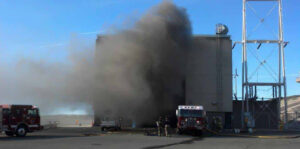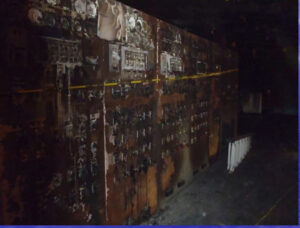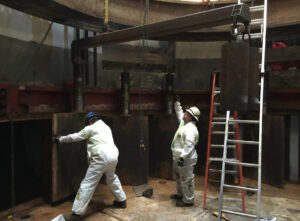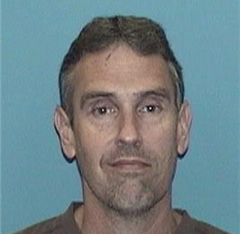California’s Department of Water Resources (DWR) is charged with overseeing the State Water Project (SWP) through the constructing, operating, maintaining, and ensuring the safety and efficiency of the SWP’s dams and hydropower infrastructure. The SWP provides water and power to millions of Californians and their homes, farms, and businesses. This charge was tested in 2012, when the Thermalito Pumping-Generating Plant caught fire on Thanksgiving Day, effectively wiping out the plant’s power generation abilities. In this interview, Tim Kennelly, the assistant division chief for engineering services in the division of operations and maintenance at the DWR, tells Hydro Leader about the damage caused by the fire, the extensive rebuilding and modernization effort the department undertook after it, and how those efforts have improved safety and are reducing the environmental effects of California’s water infrastructure.
Hydro Leader: Please tell us about your backgrounds and how you came to be in your current positions.
Tim Kennelly: I’ve been with the DWR for 22 years, all in the division of operations and maintenance and most recently for the Thermalito project. I served as the principal hydroelectric power utility engineer in charge of the electrical engineering services office. As part of those duties, I was the project/program manager for the Thermalito power plant restoration program.
Hydro Leader: Please describe the Thermalito plant and its role in the Oroville-Thermalito complex.

Tim Kennelly: The plant itself is located about 70 miles north of Sacramento, on the western side of the city of Oroville. It was built in the late 1960s and became operational in 1968. It is owned and operated by the DWR. The Thermalito plant is one of three plants in the Oroville-Thermalito complex. There are four units in the Thermalito plant, three of which are pump-generator units and one of which is a generation-only unit. The Thermalito power plant can produce about 118 megawatts (MW), which is enough to power about 100,000 households. The complex also includes the Hyatt power plant, which is located next to the Oroville Dam, and a smaller power plant called the Thermalito diversion dam power plant. Hyatt is able to produce 714 MW and the diversion dam power plant can produce about 3.3 MW.
Adding all that up, the complex can produce about 835 MW of electricity, which is enough to power 1.6 million homes.
Hydro Leader: Please tell us about how the 2012 fire occurred and what damage it did.
Tim Kennelly: The exact cause, unfortunately, was never determined. All the investigations were inconclusive, mainly because the fire incinerated and destroyed most of the evidence. The forensic and laboratory analysis wasn’t sensitive enough to detect the cause. We suspect that the fire started in the wiring in a cable tray located on the floor directly below the plant’s control room. It basically destroyed the plant’s entire operating capacity. There was no way to generate any power with the plant afterward. It destroyed all the electrical systems, the communication and control systems, and the protection system. The fire was so intense that it did some structural damage to the concrete walls and floors inside the plant. Luckily, there were no staff members present because it was Thanksgiving Day. There were no injuries during the fire.
It happened that one of the plant’s employees was a local volunteer firefighter and responded to the fire and assisted the firefighting response team. That employee, Kevin Mefford, received the governor’s medal of valor, the state’s highest safety award, for his assistance to the firefighters during that fire. Only one-third of the Thermalito power plant is above ground—all the other floors are below ground—so Mr. Mefford’s knowledge of what was where in the plant was invaluable. He helped make sure they were safe by guiding them to where they needed to be and helping them safely find their way out safely.
Hydro Leader: What were the effects on the broader electricity supply, on water delivery, and on the operations of the complex more generally?
Tim Kennelly: Because the plant could not generate any power, the SWP had to purchase additional power on the grid market. Our generation generally goes to help pay for the costs of pumping and moving the water. We were still able to maintain water deliveries because the plant has a bypass gate that allows us to move water from the Thermalito forebay to the Thermalito afterbay. While we were not able to move as much flow as we could have if all four units were in operation, we were still able to maintain water flows to meet the demands of local agriculture, to provide for fish habitat, and to meet other supply needs.
Hydro Leader: After the fire, how did the DWR analyze the plant, and why did it decide to restore the entire plant rather than fixing some parts of it?

Tim Kennelly: Once the plant was deemed safe to enter, there was a full assessment of the plant and an inventory of all the damage. Then there was an analysis of all the alternatives and a weighing of the options, and the option of returning the plant at least to its prefire operation was selected over decommissioning. There were two main reasons for that. First, the generation that Thermalito provides benefits not only the grid in California as a whole, but also helps lower the amount of energy we need to buy, and thereby lowers costs to our customers, the state water contractors. Second, three of the facility’s units have both pumping and generating capacity, which means they have the ability to pump water back from the afterbay to the forebay during times of low energy demand to use again during times of high energy demand. It is possible that that function could become more useful in future years to combat climate change, so having that ability was highly desirable.
Hydro Leader: Was it possible to salvage any of the equipment from the plant?
Tim Kennelly: As I mentioned, the electrical, communications, control, and protection systems were all pretty much destroyed and had to be replaced. The units themselves were salvageable. As part of the plant’s restoration, we refurbished a lot of the units’ major components.
Hydro Leader: What was the timeline of the rehabilitation?
Tim Kennelly: The fire happened Thanksgiving Day 2012. The bulk of 2013 was dedicated to fire cleanup, and plant recovery took place during 2013 and 2014. The cleanup stage was deemed complete by October 2014. Then, we began recovery of some of the essential systems, such as lighting and heating, ventilation, and air conditioning (HVAC). That was complete by July 2015. The design for the restoration and return to full operations began in 2015, ran throughout most of 2016, and really was completed by January 2017. The construction phase started in 2016 and continued through 2020. The plant was returned to normal operations and maintenance in September 2020.
Hydro Leader: Is that a pretty standard timeline for this kind of rehabilitation?
Tim Kennelly: I believe it is. I’ve done a few plant projects, plant startups, and new facilities, and it generally takes about 5–7 years in total, including design, procurement, construction, startup, and commissioning.
Hydro Leader: Would you talk about the safe environment challenges that were posed to the recovery workers by fire damage and contamination?
Tim Kennelly: With the age of this plant, a lot of the materials that were in there were materials that are deemed hazardous now, such as asbestos. When you add heat and water to the mix, it can create a kind of toxic soup. All the wiring was destroyed, and if you combine wiring and plastic with heat and water, it creates an acidic compound. The smoke and its byproducts were corrosive, creating a soot that coated pretty much anything it touched within the plant. It had to be dealt with carefully and in a contained manner. We instituted a rigorous cleanup and recovery program using the U.S. Environmental Protection Agency’s hazardous materials guidelines. It included wearing all necessary layers of personal protective equipment; decontamination procedures; medical checks; and, of course, hazardous waste disposal. All that was well planned, documented, and strictly adhered to.
Hydro Leader: Was the plant rebuilt exactly as it had been before the fire, or did you take the opportunity to change anything?

Tim Kennelly: We did take the opportunity to change a number of things. One of the options identified as part of the analysis I mentioned earlier was to return the plant to its prefire condition. A second option was to return the plant to operation but to do enough work to extend the life of the plant and equipment, adding essentially another 30 years, which was the option deemed the best value. We refurbished the units, for the most part, and upgraded and replaced all the destroyed equipment, such as the governor systems; voltage-regulation systems; and protection, control, and communication systems. We also took the opportunity to replace the turbine in the pure generation unit with a more efficient one. That helped with our goals for climate change investments. Replacing that turbine alone increased the efficiency of that unit from 86 to 93 percent. In addition, we focused on our fire monitoring and suppression system. New systems were added, and our existing fire monitoring system was completely revamped and expanded. We brought the plant back to its preexisting condition and then went beyond.
Hydro Leader: Have you implemented any new regulations, fire warning devices, or other measures and technologies to avoid future fires or incidents like this?
Tim Kennelly: It was an untimely coincidence that the DWR was actually beginning to embark on a fire modernization program for all our SWP facilities in early 2012, starting at Thermalito’s companion plant at Hyatt. Of course, the fire at Thermalito drove home the need to bring all plants up to modern fire codes. During the rehabilitation of Thermalito, we engaged the California state fire marshal at every step, from design all the way to our return to full operations. We had numerous conversations with the office of the fire marshal, and it reviewed all our plans and signed off on them. Throughout the construction, its staff came out numerous times to perform inspections, to make sure the systems were operating as intended, and to sign off on the whole plan before we turned it over to normal operations. We greatly expanded the fire alarm system throughout the plant; it now has even better monitoring capability than it did before. We installed things such as smoke dampers in the HVAC systems to slow the progression of smoke in case of future incidents. We installed a high-pressure water mist system, which is a fairly new technology, in the lubrication room. We installed an inert gas system in the control room for better fire containment. Since access to the plant was limited by the old design, we added three new exits to the outdoors. We upgraded the lighting system and the emergency lighting system using modern technology with LED lights. The fire modernization program will proceed from plant to plant throughout the SWP. We also implemented a robust inspection, testing, and maintenance program for our fire systems. With every design and every facility upgrade, the California state fire marshal is reviewing the designs, inspecting the systems, and making sure that they meet today’s fire codes.
Hydro Leader: Has the DWR changed operations at any other facilities based on this experience?
Tim Kennelly: The SWP’s fire system modernization program is ongoing. We’re actually getting ready to finish up Oroville and its division in their entirety. We’re going to embark on the construction phase for the next field division this summer. The inspection, testing, and maintenance program is strictly adhered to, tracked, monitored, and audited to make sure we’re keeping all the equipment in order. The other thing we did after the fire was a survey throughout our other plants. We looked for any fire risks, including materials that potentially could be fuel for a fire or help spread it, and had a plant cleanup to get rid of potential combustible materials.
Hydro Leader: Is there anything else you would like to add?
Tim Kennelly: The SWP is a major supplier of water throughout California, and it provides water to about 27 million Californians and 750,000 acres of farmland. The SWP is an extremely important resource for the state of California.
Tim Kennelly is the assistant division chief for engineering services in the Division of Operations and Maintenance at the California Department of Water Resources. He can be reached at tim.kennelly@water.ca.gov.


